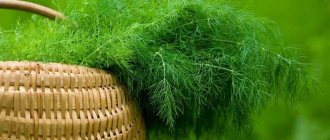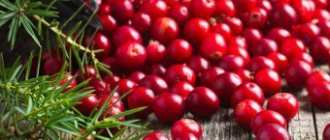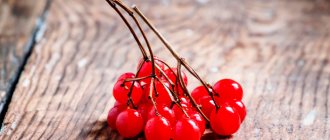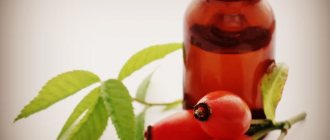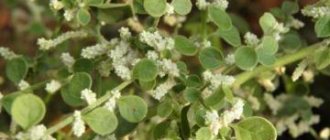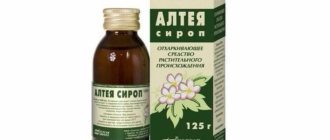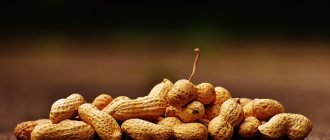Modern cooking is replete with aromatic and flavoring additives that are beneficial to the body. Typically these are spices and seasonings made from plant products. One of these seasonings is fennel, which you definitely need to pay attention to. It is fennel that brings a piquant note to the culinary arts and promotes health. Although, it is worth noting that fennel is not so popular in our country. And we know much better a related plant - dill. However, fennel is such an interesting spice that it’s definitely worth learning more about it!
Useful and healing properties
- Nutritional value of dill seeds (per 100 grams of product):
carbohydrates – 52.3 g; - fats – 14.9 g;
- proteins – 15.8 g;
- water – 8.81 g;
- dietary fiber – 39.8 g;
- ash – 8.22 g.
- Vitamins:
- vitamin A – 7 mcg;
- vitamin B1 - 0.408 mg;
- vitamin B2 – 0.353 mg;
- vitamin B6 – 0.47 mg;
- vitamin C – 21 mg;
- vitamin PP – 6.05 mg.
- Microelements:
- calcium – 1196 mg;
- potassium – 1694 mg;
- magnesium – 385 mg;
- phosphorus – 487 mg;
- sodium – 88 mg;
- iron – 18.54 mg;
- zinc – 3.7 mg;
- manganese – 6.533 mg;
- copper – 1057 mcg.
- Fatty acid:
- omega-6 – 1.7 g;
- omega-9 – 9.91 g;
- saturated fatty acids – 0.5 g.
- Amino acids:
- leucine – 0.99 g;
- isoleucine – 0.69 g;
- arginine – 0.68 g;
- lysine – 0.76 g;
- valine – 0.92 g;
- histidine – 0.33 g;
- methionine – 0.3 g;
- threonine – 0.6 g;
- phenylalanine – 0.65 g;
- tryptophan – 0.25 g.
Calorie content of Volosh dill grains: 100 grams of product contains 345 kcal. Fennel grains contain a large amount of essential oils - up to 6.5% (read about the properties and uses of fennel essential oil here).
Chemical composition
Fennel fruits are mainly used for medicinal purposes. They include:
- protein substances – up to 20%;
- sugar – up to 5%;
- fatty oils – up to 18%;
- essential oil – 2–6%.
The active components of the essential oil are: dipentene, anethole, limonene, fenchone, phellandrene, anisic acid, anisaldehyde, anise ketone, methyl chavicol, pinene.
Fatty oils contain oleic, linoleic, petroselinic, and palmitic acids.
Some recipes use the green part of the plant: the stems and leaves. The following were found in their composition:
- flavonoids;
- carotene;
- B vitamins;
- ascorbic acid;
- minerals;
- glycosides.
Photo
The photo shows what fennel and its fruits look like:
Possible Side Effects of Fennel
While fennel is an excellent, healthy vegetable choice for most people, people with certain medical conditions may need to limit or avoid fennel consumption. Some people may be allergic to certain spices, so fennel seeds should be avoided.
Due to its high potassium content, people with kidney disease should limit the amount of fennel they consume. People taking beta blockers, which are commonly prescribed to control blood pressure, may also have elevated potassium levels and may need to avoid fennel.
Application
The culture is used in traditional and folk medicine. Fennel is equally beneficial for adults and children . Decoctions from the fruits of Voloshsky dill are given even to infants and nursing women (read about the use of fennel for infants and older children here, and the beneficial properties of fennel and contraindications for women in general are written separately).
When consuming the fruit of pharmaceutical dill:
- the picture of the nervous system significantly improves;
- strengthens the heart muscles;
- useful for kidney and liver diseases;
- copes with respiratory diseases;
- for ARVI and influenza;
- stabilizes the menstrual cycle;
- improves lactation;
- eliminates colic in babies;
- has a diuretic effect;
- antispasmodic;
- choleretic effect;
- laxative effect;
- improves metabolism;
- has antiseptic properties.
Benefits for the body
The beneficial effects of pharmaceutical dill on the body are described in medieval treatises. Not all beneficial and medicinal properties have been proven and confirmed by modern research. However, it is not denied that the use of herbs and preparations based on them:
- Reduces flatulence;
- Speeds up metabolism;
- Preserves vision;
- Prevents glaucoma;
- Regulates appetite;
- Improves digestion;
- Cleanses the body of toxins;
- Reduces stress and anxiety;
- Helps lower blood pressure;
- Has a beneficial effect on the liver;
- Reduces allergy symptoms;
- Prevents gastric damage caused by ethanol;
- Has a calming effect on the nervous system;
- Relieves insomnia;
- Neutralizes the effects of mushroom poisoning;
- Stimulates breast milk production in nursing mothers.
Contraindications
Fennel grains have some contraindications:
- for epilepsy;
- during pregnancy;
- in case of individual intolerance to the substance (allergy);
- persons with acute heart failure;
- during severe intestinal ailments.
More about the beneficial properties and contraindications of fennel is written in a separate article.
What is it and what does it taste like?
What does fennel taste like? Fennel seeds and tubers have a sweetish taste , while they are spicy with the smell of anise. Greens with dill flavor and an aniseed note. This is not surprising, because fennel is a relative of regular dill.
There are two food varieties of this plant: ordinary (for obtaining leaves and seeds) and vegetable (headed). Leaf fennel varieties have a more pronounced smell and taste.
Vegetable varieties form heads of cabbage instead of roots. For greens, it is better to purchase seeds of the “Aroma” or “Autumn Beauty” varieties (distinguished by a bluish coating on the leaves and a more delicate aroma). To get onions for food, choose the varieties “Udalets” (onion up to 350 grams) or “Luzhnikovsky Semok” (onion up to 250 grams).
Fennel should be consumed when it is ripe. The leaves are not too large, and the head is white-green. Old, overripe plants are tough and lose their flavor.
Recipes from Voloshsky dill seeds
For skin
The green helper is good in the fight against dermatitis, has a rejuvenating effect, and heals cuts and wounds.
Recipe: Use half a liter of cold water per tablespoon of fruit. Bring to a boil, then simmer over low heat for 20 to 30 minutes. The broth must be cooled and strained. The medicine is ready for use: you can make lotions and compresses.
It is important to remember that this lotion is stored for no more than 48 hours . When used after the expiration date, it can cause harm to the skin, as degrading acids appear in the product.
For immunity
Tonic tea made from pharmaceutical dill helps increase vitality and protect the body.
Recipe: to make tea you need to pour 200 ml of boiling water over 20 g of fennel seeds. The drink is ready to drink in half an hour.
You need to take it three times in 24 hours . Ready-made tea can be purchased in pharmacies.
Read about the medicinal properties of fennel tea, how to prepare it and what ready-made products are available in another material.
For cellulite
Taking fennel seeds reduces appetite, breaks down fats in the blood and improves metabolism, which leads to excess weight loss.
Recipe: to prepare the solution you need to boil 2 liters of water, add 4 tablespoons of dill seeds. Then remove from heat and cool the drink with the lid closed.
Drink one cup a day (you can gradually increase the amount of fluid consumed to a liter).
From toxins
Fennel grains will help cleanse the body and get rid of toxins.
Recipe: pour a teaspoon of crushed (crush) seeds into a cup of boiling water. You can add other components at your personal discretion. Suitable additives include basil leaves, black pepper, honey, etc. This tea is infused for 10 to 15 minutes . It is recommended to drink the drink once a day.
For hair
A decoction of fennel seeds will help restore hair.
Recipe: pour a tablespoon of dill seeds into a liter of boiling water. The decoction must be infused for 60 minutes . Then strain.
This balm should be used after washing your hair as a rinse.
To improve the functioning of the gastrointestinal tract, for constipation
A decoction will help cope with problems of the liver, pancreas and intestines.
Recipe: Grind (or crush) 25 g of dill seeds and pour half a liter of boiling water. Cool the potion for an hour. Divide the resulting liquid into 10 equal portions. It is recommended to store the medicine in the refrigerator. Take 2-3 times a day.
For your appetite
Recipe: mix half a teaspoon of fennel fruit with a pinch of ginger and pour a glass of boiling water. To improve the taste, you can add honey. This drink infuses for a couple of minutes. Drink it before or during meals.
In the treatment of respiratory diseases
Recipe: 5 g of ground pharmaceutical dill grains are poured with a glass of boiling water and infused for 10-15 minutes. Strain the tea, add a spoonful of honey . It is recommended to consume 2-5 cups of medicine per day.
To stimulate lactation
Recipe: Pour 30 g of fennel seeds into a glass of boiling water. The decoction is infused for an hour. You need to take the drug three times a day before meals.
For cholecystitis
Recipe: pour 15 g of crushed Volosh grains into a glass of boiling water. Leave the elixir for 60 minutes. Take 4 times a day, 1-3 tablespoons .
Historical facts
This root vegetable originated in the Mediterranean countries of Greece and Italy, but is now grown in many countries, including Russia, India and the United States. It is typically harvested in the fall and is usually featured in recipes in the fall or winter.
Fennel has a rich history of use for its many nutritional benefits. Since the time of Hippocrates it has been used as a medicine. The Romans considered fennel a sacred ritual object and used it as a digestive stimulant. The Greeks used fennel during their ceremonies because it symbolized pleasure and prosperity. And the ancient Chinese and Egyptians used this vegetable as food and medicine.
For centuries, fennel has been used in various Mediterranean countries for cooking and baking. It was even added to loaves of bread to add extra flavor and make it easier to digest.
Fennel is also used to make absinthe, an alcoholic drink with a very high alcohol content (45 to 74 percent) and known for its natural green color. Absinthe is made from medicinal and culinary herbs, including anise and fennel. It originated in Switzerland in the late 18th century and is known for its hallucinogenic properties. Today, absinthe is not allowed to be sold in bars or retail stores.
Use in cooking
The spice has found application in Chinese, Indian, Caucasian, Hungarian, Italian and other cuisines of the world. The fruits can be found in soups, main courses, sauces, with fish and meat, marinades, cold and hot appetizers, and also as a drink (fennel tea).
Seeds with a spicy-sweet taste. Most often it is used as a spice (whole grains or in powder form) or for frying in a pan (more about what fennel spice is and how it is used is written here).
The seasoning is also used in desserts : for puddings, cookies, and other sweets. They are also used for making liqueurs.
Find out more details about what can be prepared from fennel, how it is used in cooking and medicine, in another material.
What kind of plant is this
Fennel has been known since ancient times. It appeared in Europe in the 16th century thanks to the Benedictines, who grew grass in monastery gardens. Now grown all over the world.
Belongs to the Umbrella family. Herbaceous one-, two-, or perennial plant up to 2 meters high. The green stem is hollow inside.
It blooms with yellow flowers. The leaves are pinnate and green.
Seeds up to 10 mm long, elongated, light brown with thin vertical stripes. Sweet to taste, comparable to licorice. Thanks to their taste, they have gained popularity in many cuisines around the world, where they are used as a spice for meat dishes, fish, baked goods or alcoholic beverages. They have a characteristic anise smell and can be consumed raw.
The Mediterranean and Asia Minor are considered their homeland. Grown in Ancient Rome and Greece. It is currently cultivated on a large scale in China and India.
In the Middle Ages, it was believed that the herb could protect against evil spirits.
Fennel is called pharmaceutical or Voloshsky dill. Although the herb is in the same family as dill, it is a completely different plant.
Where can I get the plant?
Instructions on how to grow
You can grow a green miracle both from seeds and by seedlings. Planting in the garden occurs in mid-spring - April.
Gardeners recommend planting fennel away from other plants: if the root crop does not have enough moisture, it will, with the help of long roots, begin to take it away from its neighbors in the garden.
Fruit harvesting occurs at the end of April - beginning of September. The grains do not ripen evenly. Initially, those in the center are harvested, then the rest of the crop.
Where to buy and how to choose?
You can buy fennel in stores, at pharmacies, or order online. The fruits are usually bright or light green in color. This is a sign of their freshness. In Moscow, the average cost of pharmaceutical dill seeds is 447 rubles/kg, in St. Petersburg – 435 rubles/kg.
Growing in open ground
Fennel has a thick, spindle-shaped tap root. The stem is erect, branched. The leaves are pinnately dissected. The plant reaches up to 2 m in height. The fruit is ovoid-oblong with pronounced blunt ribs, elongated at the edges. The petals are broadly ovate, yellow, notched at the apex. The grass is propagated by sowing seeds or dividing the bush.
Requirements for landing
Deadlines
Best materials of the month
- Coronaviruses: SARS-CoV-2 (COVID-19)
- Antibiotics for the prevention and treatment of COVID-19: how effective are they?
- The most common "office" diseases
- Does vodka kill coronavirus?
- How to stay alive on our roads?
Fennel ripens quickly, so it can be rooted throughout the warm period of the year. He does not tolerate long daylight hours. To get a harvest, the plant is planted in the ground from April 15 to the end of May and from August 15 to September 15. To obtain planting material for next year, wait until the seeds are completely ripe. They can only be obtained from early spring sowing (late April). Otherwise, fennel is grown as seedlings in pots at home. Among the sprouts that have emerged, the strongest is selected and rooted in open ground. In order for the plant to take root, the beds are covered with film.
The soil
Fennel grows well on loamy, sandy loam soils and black soil. In the wild, it is found in weeds, rocks, foothills and steppes. However, to obtain a high yield, the soil for sowing must be moist, loose and fertile. To do this, humus, sand, sawdust, compost, dolomite flour and ash are added to the soil.
Place
Choose a sunny or slightly shaded place for planting. The optimal temperature for growing fennel is 16-20 degrees above zero. When the indicator decreases to 7 degrees or increases to 24 degrees, growth slows down.
It is recommended to plant the plant near cabbage or cucumbers, since they are also moisture-loving. In addition, fennel essential oils repel aphids, thereby protecting vegetables. The plant should not be planted in close proximity to beans, beans, tomatoes, spinach and peppers.
Planting by seeds
Fennel fruits are oblong seeds of greenish-brown color, measuring 3 mm x 10 mm. When planted in early spring, it blooms in July. The seeds ripen in September. They are collected from umbrellas.
First of all, it is necessary to moisten and feed the soil. For 1 sq.m. future beds add 0.5 kg of ash and a bucket of humus and compost. If the soil is too depleted, additionally add ready-made liquid fertilizers. The seeds are buried 2 cm into the ground, maintaining a distance between rows of 40 cm. The first shoots appear after 3 weeks, since essential oils slow down the penetration of moisture into the kernels, as a result, their growth is inhibited. The seedlings are thinned out. The distance between plants should not be less than 15 cm.
Primary requirements:
- Sufficient hydration. Remember, fennel loves moisture. Without regular watering, vegetable varieties will not produce fleshy heads, and the plant will stop growing and begin to die. The soil should always be moist. In dry weather, fennel is watered every other day, and in the fall, during the rainy season, as needed.
- Removing flower stalks when there is no purpose for collecting seeds.
- Loosening the soil, weeding, mulching. These operations will help maintain moisture in the soil and relative cleanliness in the beds.
- Rolling vegetable varieties. The procedure improves the setting of heads.
- Feeding with chicken manure, organic matter, and ash throughout the season.
For greens, the medicinal variety of fennel is harvested when the base of the root is no more than 1 cm in diameter, without waiting for the crop to flower. The top is cut off, used fresh or dried, frozen, or added to canning. Harvesting of the vegetable variety occurs during the period when the head of cabbage reaches a size of 10 cm. After this, it is consumed immediately or placed for safekeeping in a dark, cool and damp room. In the second case, the head of cabbage is cleared of leaves, the stems are cut, and 10 cm of petioles are left without touching the roots.
How to store?
Whole fruits should be stored in a cool place for no more than six months. It is best to store crushed fennel seeds in the refrigerator .
The fruits of pharmaceutical dill are a golden fund of useful substances available to everyone. The plant can be grown independently or purchased commercially. Do not forget to follow the proportions when preparing a decoction or tea, and monitor the safety of the product. Fennel is your faithful ally in the fight against various diseases. It is also a tasty addition to many dishes.
Read on our website about fennel seasoning, its properties, storage nuances and rules of use, as well as the use of the plant root in cooking and medicine.
Comparison of fennel with anise, licorice and dill
Fennel is a plant from the carrot and celery family. It tastes like anise and is also very aromatic.
Fennel, star anise and anise seeds contain anethole, an aromatic compound believed to fight cancer, inflammation and diabetes.
Fennel has been used as a medicine for thousands of years. Has antioxidant and anti-inflammatory effects. Like anise and licorice, fennel is also used to fight bacterial, fungal and viral infections.
Anise
Anise is used as a spice to add flavor to various dishes. Anise and anise seeds are two different spices that come from different plant families. However, they have similar flavor profiles because they both contain anethole.
Like fennel and licorice, anise and star anise seeds have a strong aroma and their flavor is often described as sweet and licorice-like.
Anise seed is known for its ability to fight bacterial and fungal infections, regulate blood sugar levels, improve heart health, relieve symptoms of depression, and ease menopausal symptoms.
Licorice (licorice)
Licorice root is an adaptogenic herb that is used in Chinese medicine for its anti-inflammatory properties.
Licorice is a member of the legume family and, like fennel, contains powerful flavonoids rich in antioxidants.
Like fennel and anise, licorice helps relieve digestive problems and alleviate reproductive problems in women, including PMS and menopause. Licorice is also beneficial for people suffering from respiratory problems, leaky colon and adrenal fatigue.
Why does bloating occur?
Bloating and flatulence can be caused by various reasons. But in any case, these are symptoms indicating possible problems with the digestive system. Increased gas formation is accompanied by the vast majority of diseases of the gastrointestinal tract (GIT). One of the causes of bloating may be aerophagia - swallowing air while eating. This can happen due to conversations during feasts, during quick snacks on the go and due to factors such as smoking, poor-quality jaw prostheses, etc.
Another common cause of discomfort after eating, leading to bloating, is the consumption of foods that increase gas formation and poorly tolerated foods, such as milk2.
Even in completely healthy people, flatulence can occur when consuming the following foods:
- legumes: peas, beans, lentils;
- vegetables: cauliflower, Brussels sprouts, white cabbage, broccoli, radishes, celery;
- some grains: bran, wheat germ, corn;
- baked goods: pies, buns, bagels;
- sweets: cookies, cakes, pastries, ice cream;
- flour: bread, dumplings, pasta;
- dairy products, especially fresh milk;
- fruits with a high fructose content: grapes, figs, melon, pear, dates;
- carbonated drinks and fruit juice concentrates;
- containing cocoa: coffee, chocolate.
The appearance of bloating can be caused by impaired digestion of carbohydrates entering the body with food. The reason for this may be a lack of digestive enzymes. If the body does not have enough digestive enzymes, their deficiency must be compensated. For this purpose, there are preparations that contain the required amount of enzymes similar to those produced by the body3. Such drugs include Creon®. The drug is available in the form of capsules that contain hundreds of small particles - minimicrospheres. Today, this is the most effective form of release of pancreatin, the active ingredient of enzyme preparations4. It is important to note that Creon® minimicrospheres are produced using patented technology and therefore other drugs cannot replicate it. Why are small particles needed? Enzyme preparations are designed to improve digestion, that is, break down and digest food. To perform this task, the drug must be evenly mixed with food. Only in this way will he be able to capture and help “process” the maximum amount of food eaten. If the drug does not have small particles, then it will only partially affect food.
FROM MENSTRUAL CRAMPS AND FATIGUE
Several clinical trials have shown fennel to be effective in reducing cramps and fatigue associated with menstruation. In one, researchers compared the use of fennel extract with the use of nonsteroidal anti-inflammatory drugs (NSAIDs). The young women were divided into two groups: one group took fennel and the other took NSAID drugs. After two menstrual cycles in a row, those who took fennel experienced greater improvement in their condition than those who took medications. It's important to note that fennel is not only more effective than brand name drugs, but it has a much better safety rating than NSAID drugs.
What it looks like and where it grows
In appearance, fennel resembles dill. The height of the rounded branched stem reaches from 90 cm to 2 m. Oblong leaves on petioles, expanded at the base, are attached to the lower part of the stem. Closer to the top of the plant, the shape of the leaves changes and becomes pinnately dissected. The vegetable variety has a fleshy stem.
The plant is demanding on soil composition and light-loving. In the non-chernozem zone of Russia it is cultivated as an annual, as it does not tolerate harsh winters. It takes root well in the Krasnodar Territory, Ukraine and Moldova, where the climate corresponds to optimal conditions for early ripening and wintering.
Fennel is also grown in the USA and Europe, Japan, China, and India.
The fruits of the celery plant are part of the national cuisines of countries such as:
- Romania;
- Spain;
- Hungary;
- Italy;
- France.
Fennel blooms during the summer months. The fruits ripen in September - mid-October.
Marathon, a story about an English doctor, children's gas and mother's milk
The name of fennel in Greek is “marathon” (μάραθον). We know this word thanks to traditional long-distance running, but few people know that it is also the name of the place where, in ancient times, a grandiose battle took place between the Persians and the Athenians (and where the same messenger came running with the long-awaited news). It is translated as “the valley where the fennel grew.” And the hero Prometheus, when he produced fire at the top of Olympus, brought it to humanity, chilled and dark in every sense, precisely on a fennel stalk - the essential oils of the plant supported even combustion.
A certain Doctor Stephenson went down in the history of British medicine as a real luminary of science, as he masterfully treated diseases of the respiratory organs and kidney diseases with a certain magic remedy, the recipe of which he refused to disclose to competitors for years. Presumably, his medical fame and the kilograms of pure sovereigns and guineas he earned turned pharmacists and doctors against him: in 1739, the English Parliament issued a special order, which obliged the Aesculapian to reveal his secret. To the amazement and chagrin of the medical world, the potion consisted almost entirely of a concentrated fennel infusion. Stephenson must have had a lot of fun: his own fee for selling the recipe amounted to an impressive amount - as much as five thousand pounds sterling!
Nowadays, it is customary to give fennel decoction to children from the very first days of life, when their stomach hurts, and mothers of children drink fennel tea so that their babies have more tasty breast milk.

